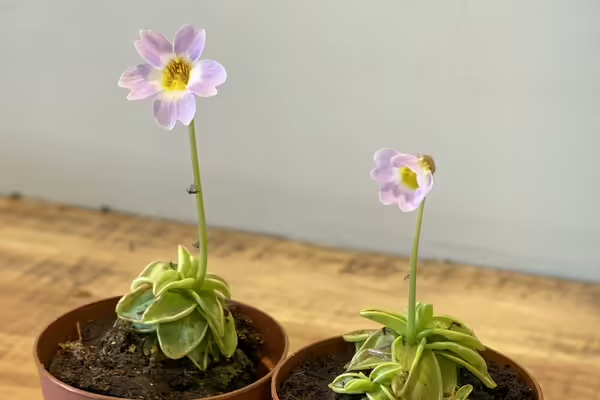
URBANA, Ill. – During the chilly, dreary winter months, I enjoy my green houseplants that add a bright spot in my office and living space. So when I was visiting a new specialty plant shop this fall, I had to add a new plant friend, “Ping,” to my collection.
If you have ever dealt with annoying fungus gnats that have crept into your houseplant’s space, you should try a Pinguicula or commonly named butterwort. Butterworts are carnivorous plants commonly referred to as “Pings” from their scientific name Pinguicula gigantea. This plant was found in Oaxaca, Mexico, by the famous botanist Alfred Lau. These carnivorous plants have been found to grow in zones 7 to 10 outdoors.
What are carnivorous plants?
These unique plants are defined by their ability to trap, kill, and digest their prey and then use the nutrients from the captured insects. Prey are lured to the plant by a specialized rosette or succulent leaves that function like flypaper. The leaves have tiny hairs that make a sticky mucus that not only shimmers in the sunlight but produces a fungus or moldy odor that attracts insects. The sticky leaves then trap the prey while the leaf margins slowly roll over the insect. This starts the digestion process.
One bonus of this succulent-like plant is that it produces a vibrant-colored flower from early spring to summer. This flycatcher process is great for smaller insects such as gnats or thrips but is not effective for larger pollinators. Research shows that since bumblebees are larger-bodied insects, they will not be threatened by this plant.
Talk about a cool beginner plant for kids. Who wouldn’t love a plant with gooey leaves and a diet of bugs for dinner?
Carnivorous plant care tips
- Do not use tap water or well water. Use distilled or rainwater with low mineral water instead.
- Water using the tray method. Avoid overhead watering of the leaves that may lead to disease issues.
- “Pings” need high humidity. Using the tray watering method will help with this.
- Use soil or growing substrate. This is two-parts peat, one-part sand, one-part perlite or vermiculite.
- In winter, grow indoors with southern exposure light. Use a windowsill or supplemental lighting.
- Use terrariums with LED lighting and good airflow.
- Plant in plastic or glazed ceramic containers. Using porous terra cotta pots will make the soil dry out too quickly.
For more research-based information on carnivorous plants, connect with your local Illinois Extension county office at go.illinois.edu/ExtensionOffice.
Christina Lueking is an Illinois Extension horticulture educator for Bond, Clinton, Jefferson, Marion, and Washington counties. Gardeners Corner is a quarterly newsletter from gardening experts around the state. Each issue highlights best practices that will make your houseplants, landscape, or garden shine in any season. Join the Gardener’s Corner email list at go.illinois.edu/GCsubscribe for direct access to timely tips.
ABOUT EXTENSION: Illinois Extension leads public outreach for University of Illinois by translating research into action plans that allow Illinois families, businesses, and community leaders to solve problems, make informed decisions, and adapt to changes and opportunities.
Photo: Butterworts are carnivorous plants commonly referred to as “Pings” from their scientific name Pinguicula gigantea. Photo credit: Christina Lueking.
PHOTO ACCESS: The photo in this article is available to download for media use.